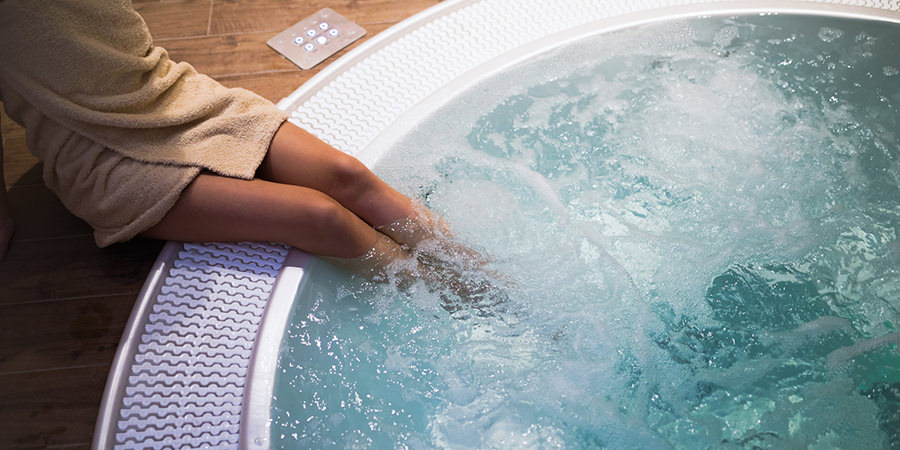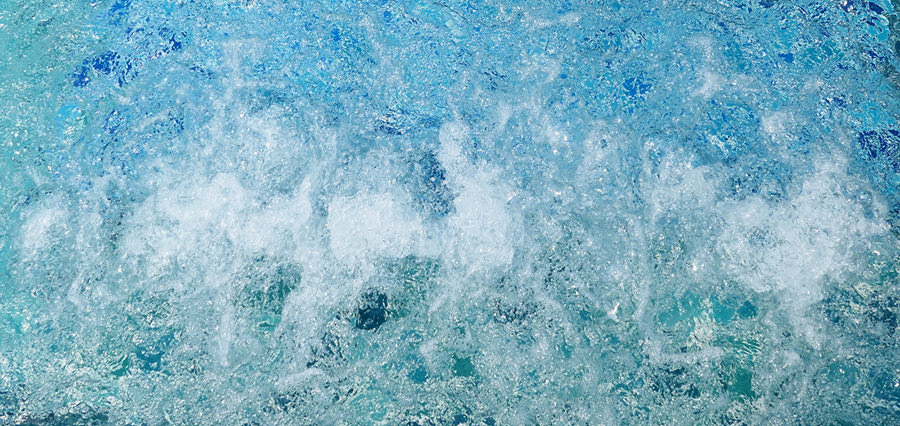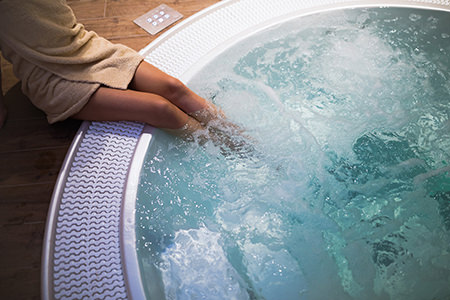
We all know that hot tubs use a lot of electricity warming up the water and that sometimes it can take as much as 24 hours for a full hot tub to get up to working temperature from cold. So, it seems like it might be a good idea to fill your hot tub with warm water to save on all of that electricity and also to enable you to jump in and start relaxing immediately rather than having to wait.
So, is it a good idea to fill up your hot tub with hot water in the first place or are there some drawbacks and problems using this method? I decided to do some research to find out:
So, can you fill a hot tub with warm water? Yes, you can fill a hot tub with warm water but it’s not generally recommended. If the water is too hot there is a risk of damage to the shell of the hot tub, some household hot water supplies can have a high level of bacteria and debris in them and some will also have water softeners which can invalidate hot tub warranties if soft water is added to them. It’s a much safer idea to fill up with cold and then let the hot tub heat it up.
Why it’s not really a good idea to fill your hot tub with warm water
Risk of damage to the hot tub shell – Hot tubs are designed for a maximum working temperature of 40 degrees C. The recommended minimum temperature for a domestic hot water storage tank is 60 degrees C as this is hot enough to destroy any bacteria that might be present. So, this means that if you put water straight from your household hot water system into your hot tub then you risk exposing the hot tub shell to temperatures of 20 degrees C or possibly even more than the shell was designed to endure.
This could lead to cracking, blistering or other damage that in all likelihood won’t be covered by your warranty and will be expensive to fix. The obvious solution to this is to add cold water first to keep the temperature down or to make sure that your hot water system is temporarily turned down well below 40 degrees C when you fill your hot tub.
Problems with soft water – A lot of household hot water systems include some sort of water softening filter included with them and, if you do add softened water to a hot tub it can cause damage which again won’t be covered by your warranty.
If the water in your hot tub is too soft it can cause corrosion to the internal working parts and if it is too hard it will cause calcium deposits. If you must fill your hot tub from the hot water system then make sure that you check the calcium hardness level soon afterwards and correct as necessary.
If you need some calcium hardness test strips then these on Amazon will do the trick.
Temperature cut out – If you fill your hot tub with water that is too hot you will probably trip the temperature cut out on your heater. This can temporarily mean that the hot tub doesn’t work as it is protecting itself from the excessive temperature.
There is a risk that you will damage the internal mechanisms of the hot tub if the water is too hot. You could really do some serious damage to your hot tub if the water is too hot if you manage to damage both the internal workings and also damage the shell!
Hot water system capacity – If you have an average domestic hot water system with a hot water tank then your tank will probably hold around 180 litres of water. If you have a combination boiler and the hot water continues to flow then it will probably be capable of producing between 10 and 20 litres per minute of hot water.
Your hot tub may well need between 300 and 500 litres of water to fill it. Assuming that you turn the temperature of the boiler down to below 40 degrees C to prevent damage to your hot tub it would require two or more full tanks of water or up to an hour or more to fill if you have a continuous flow boiler. You could possibly speed the process up if you partly fill with cold water first though although you would need a thermometer to keep track of the temperature as the water mixed.

Is it just me, or is the idea of filling with hot or warm water just becoming too complicated? Even if you did decide that you could get the temperature right you will really need two hoses to add hot and cold together.
How much money would you really save by heating the water via your household system and is it really going to be that much quicker than filling with cold in the normal way and allowing the hot tub to bring itself up to temperature?
Bacteria and debris – If you have a hot water system that uses a hot water storage tank then the chances are that it will contain bacteria and debris that are usually harmless but, once introduced to the hot tub could cause problems. You might find that your filtration system has to work extra hard for a while to clear the water which uses extra energy and may require further maintenance in terms of filter cleaning and changing etc.
There’s also the remote chance that waterborne bacteria that are safely kept at bay in the higher temperatures of the household hot water system will start to grow and multiply in the cooler hot tub environment.
Filter on your hose – Finally, one of the big advantages of using a mains pressure cold water garden hose to fill your hot tub is that you can add a filter to it to remove copper, iron and magnesium from the water. These are present in tiny amounts in all water and can cause problems of water discolouration and other problems with your water chemistry.
Once in the hot tub they are difficult to remove which is why it’s recommended to use a filter on the hose when you fill your hot tub with water for the first time. If you use water from a hot water system there may well not be enough pressure to use an in hose filter and if you do, you run the risk of overworking the pump on your hot water system and damaging it.
This is a really good hose filter system available on Amazon.
What if I still want to fill my hot tub with hot water?
If you are really dead set on filling your hot tub with warm water, first of all, ask yourself why? Is it because you think it might save on your heating bill or can you not wait for it to warm up in the usual way? Financially, by the time you’ve heated the water, you will use in your domestic heating system and possibly risked damaging your hot tub then the financial gains are going to be fairly negligible.
Bear in mind that you may well need to buy a second hose so that you can add both cold and hot water simultaneously and maybe a thermometer to keep an eye on the temperature and the cost difference essentially disappears.

Timewise, can you really not plan ahead and let the hot tub heat up for when you are going to be ready to get in it? Even if you fill with hot water from your domestic hot water system it will take some time to get the temperature correct and you will probably need to allow the hot tub heater to heat up the final few degrees anyway!
However, if you insist on going ahead then you will need a hose to your hot water system, a hose to your cold water system and a thermometer.
Start by quarter filling the hot tub with cold water and then add hot water. Regularly check the temperature and bring it up to around 30 – 35 degrees C. You will need to balance the adding of hot and cold water until the hot tub is at this temperature and is completely full. At this point switch on the hot tub heater to bring up the temperature the final few degrees and check your calcium hardness levels.
Related Questions:
Does a hot tub heat up faster with the jets on? If the hot tub jets are on whilst the hot tub is heating up it will take longer for the water to get hot. The movement of the water through the jets exposes a larger surface area of the water to cold air and so it takes longer to heat. However, if you do turn the jest on it will move the water around and, although take a little longer to heat the water will heat more evenly. Always have the hot tub cover on when you are heating the water up to help with insulation and speed the process up.
How to heat up a hot tub fast
A hot tub will usually heat up the water between 3 and 6 degrees C per hour. However, there are a few things that you can do to keep the heating up time to a minimum and to make the process more energy efficient.
Use a good quality thermal cover – Keep the cover on whilst you are heating the hot tub to insulate it from cold outside air
Service the components – Make sure that your hot tub heater is in good condition and that the filtration system is clean and well maintained. Poorly maintained hot tubs use more energy and take longer to heat up.
Shelter your hot tub – Keep your hot tub away from cold prevailing winds and try to position it in a sheltered sunny spot. Not only will it be more pleasant to use in these areas but it will heat up and be more energy efficient as well.

